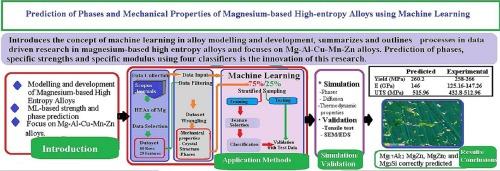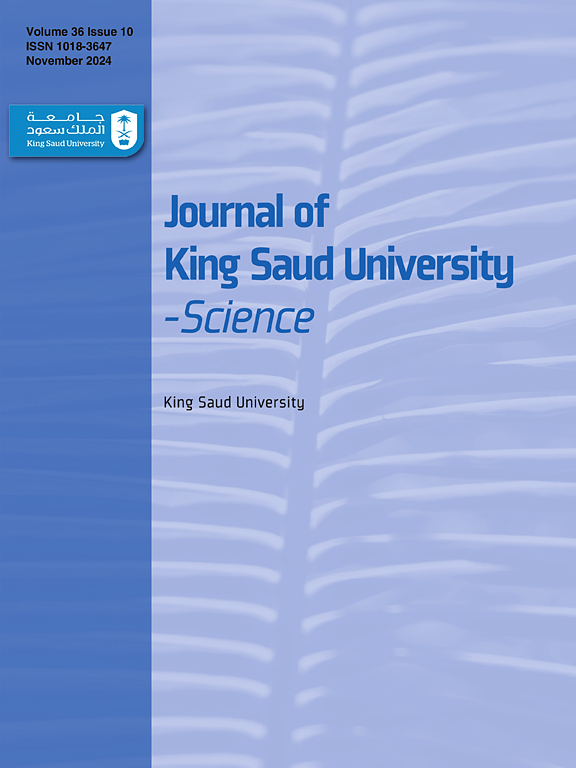Prediction of phases and mechanical properties of magnesium-based high-entropy alloys using machine learning
IF 3.7
3区 综合性期刊
Q1 MULTIDISCIPLINARY SCIENCES
引用次数: 0
Abstract
Objectives
To predict phases and mechanical properties of Mg-Al-Cu-Mn-Zn alloys and to validate the results.
Methods
In this study, 29 predictor features of the alloys were examined based on dataset drawn from relevant publications. The correlation of selected predictor features with mechanical properties of Mg-Al-Cu-Mn-Zn alloys were evaluated. New features specific to vehicle and aerospace applications were used. Feature selection schemes involving four machine learning (ML) classifiers that included artificial neural networks (ANN), linear discriminant analysis (LDA), random forest regression (RF) and k-nearest neighbours (k-NN) were adopted. Tensile test was carried out based on ASTM E8 standard.
Results
Results of correlation of features showed that specific strengths and specific modulus of the alloys were strongly and positively correlated with composition of alloying elements but strongly and negatively correlated with composition of magnesium. The results also revealed that homogenization temperatures and time were weakly correlated with the mechanical properties and phases while electronegativity difference and VEC had significant positive correlation. ANN was the best performing classifier followed by k-NN, LDA, and lastly RF with prediction accuracy on test data of 98.7%, 98.1%, 97.9% and 97.8%, respectively. The validity and applicability of the model was tested with three magnesium-based alloys: Mg-80-Al-10-Cu-5-Mn-5-Zn-0, Mg-80-Al-5-Cu-5-Mn-5-Zn-5 and Mg-91.2-Al-8.3-Cu-0-Mn-0.15-Zn-0.35 and compared with findings in literature. The model had higher prediction accuracies compared to previous ML models used on magnesium alloys. The model was then used to predict phases in the Mg-89.43-Al-8.16-Cu-0.34-Mn-0.25-Zn-1.81 alloy and it accurately predicted presence of Mg17Al12, Mg2Si, MgZn and MgZn2. Results of simulation in MatCalc version 6.04 also verified presence of the phases. The phases were further confirmed through SEM/EDS analysis.
Conclusions.
Dominant strengthening phases were Mg17Al12, Mg2Si, MgZn and MgZn2. Predicted yield strength, ultimate tensile strength and Young’s modulus were within the range of experimental results. Specific strengths and specific modulus were also within the range.

利用机器学习预测镁基高熵合金的相位和机械性能
目标预测镁铝铜锰锌合金的相位和机械性能,并验证结果。方法本研究根据从相关出版物中提取的数据集,对合金的 29 个预测特征进行了研究。评估了所选预测特征与镁-铝-铜-锰-锌合金机械性能的相关性。还使用了汽车和航空航天应用的特定新特征。特征选择方案涉及四种机器学习(ML)分类器,包括人工神经网络(ANN)、线性判别分析(LDA)、随机森林回归(RF)和 k-近邻(k-NN)。结果特征相关性结果显示,合金的比强度和比模量与合金元素的组成呈强正相关,但与镁的组成呈强负相关。结果还显示,均质温度和时间与机械性能和相位的相关性较弱,而电负性差异和 VEC 具有显著的正相关性。ANN 是性能最好的分类器,其次是 k-NN、LDA,最后是 RF,对测试数据的预测准确率分别为 98.7%、98.1%、97.9% 和 97.8%。该模型的有效性和适用性通过三种镁基合金进行了测试:Mg-80-Al-10-Cu-5-Mn-5-Zn-0、Mg-80-Al-5-Cu-5-Mn-5-Zn-5 和 Mg-91.2-Al-8.3-Cu-0-Mn-0.15-Zn-0.35,并与文献研究结果进行了比较。与以前用于镁合金的 ML 模型相比,该模型具有更高的预测精度。随后,该模型被用于预测 Mg-89.43-Al-8.16-Cu-0.34-Mn-0.25-Zn-1.81 合金中的相,并准确预测了 Mg17Al12、Mg2Si、MgZn 和 MgZn2 的存在。MatCalc 6.04 版的模拟结果也证实了这些相的存在。结论:主要的强化相为 Mg17Al12、Mg2Si、MgZn 和 MgZn2。预测的屈服强度、极限拉伸强度和杨氏模量都在实验结果的范围之内。比强度和比模量也在范围之内。
本文章由计算机程序翻译,如有差异,请以英文原文为准。
求助全文
约1分钟内获得全文
求助全文
来源期刊

Journal of King Saud University - Science
Multidisciplinary-Multidisciplinary
CiteScore
7.20
自引率
2.60%
发文量
642
审稿时长
49 days
期刊介绍:
Journal of King Saud University – Science is an official refereed publication of King Saud University and the publishing services is provided by Elsevier. It publishes peer-reviewed research articles in the fields of physics, astronomy, mathematics, statistics, chemistry, biochemistry, earth sciences, life and environmental sciences on the basis of scientific originality and interdisciplinary interest. It is devoted primarily to research papers but short communications, reviews and book reviews are also included. The editorial board and associated editors, composed of prominent scientists from around the world, are representative of the disciplines covered by the journal.
 求助内容:
求助内容: 应助结果提醒方式:
应助结果提醒方式:


